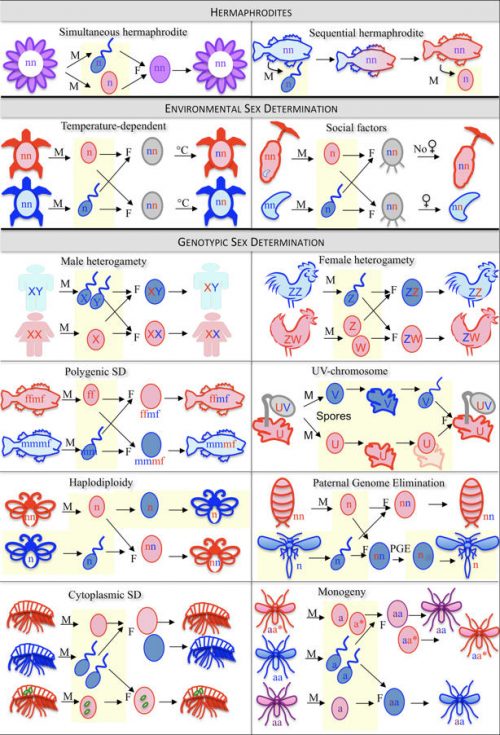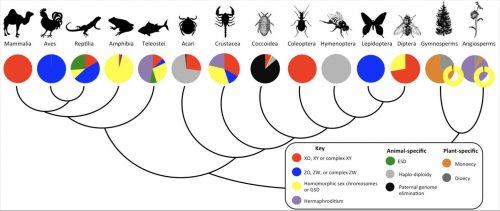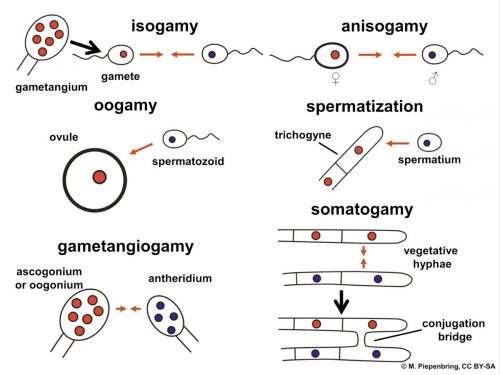I read this paper:
Bachtrog D, Mank JE, Peichel CL, Kirkpatrick M, Otto SP, Ashman TL, Hahn MW, Kitano J, Mayrose I, Ming R, Perrin N, Ross L, Valenzuela N, Vamosi JC (2014) Sex determination: why so many ways of doing it? PLoS Biol. 12(7):e1001899.
And now I give you a quick summary of a couple of figures that I know you’ll find useful if you’re teaching genetics.

Schematic overview of some sex determination (SD) mechanisms.
M refers to meiosis, F to fertilization. Haploid stages (n) are indicated as shaded areas and diploid stages (nn) are unshaded. Hermaphrodites: Most flowering plants (and gastropods and earthworms) simultaneously contain both male and female sexual organs (simultaneous hermaphrodites). Many fish and some gastropods and plants are sequential hermaphrodites; clownfish, for example, are born males and change into females, while many wrasses or gobies begin life as females and then change to males. Environmental Sex Determination: In turtles and some other reptiles, sex is determined by incubation temperature of the eggs (temperature-dependent sex determination). Social factors can act as primary sex-determining cues: sexually undifferentiated larvae of the marine green spoonworm that land on unoccupied sea floor develop into females (and grow up to 15 cm long), while larvae that come into contact with females develop into tiny males (1–3 mm long) that live inside the female. Genotypic Sex Determination: Almost all mammals and beetles, many flies and some fish have male heterogamety (XY sex chromosomes), while female heterogamety (ZW sex chromosomes) occurs in birds, snakes, butterflies, and some fish. In mosses or liverworts, separate sexes are only found in the haploid phase of the life cycle of an individual (UV sex chromosomes). In some flowering plants and fish, such as zebrafish, sex is determined by multiple genes (polygenic sex determination). In bees, ants, and wasps, males develop from unfertilized haploid eggs, and females from fertilized diploid eggs (haplodiploidy), while males of many scale insects inactivate or lose their paternal chromosomes (paternal genome elimination). In some species, sex is under the control of cytoplasmic elements, such as intracellular parasites (e.g., Wolbachia) in many insects or mitochondria in many flowering plants (cytoplasmic sex determination). In some flies and crustaceans, all offspring of a particular individual female are either exclusively male or exclusively female (monogeny).

The bubble insert graph for the plant clades represents the relative proportion of species with documented sex chromosomes within plants with separate sexes. Vertebrates: Mammalia (placental, marsupial, and monotreme mammals), Aves (birds), Reptilia (turtles, snakes, crocodiles, lizards), Amphibia (frogs, toads, salamanders), and Teleostei (bony fishes). Invertebrates: Acari (mites and ticks), Crustacea (shrimps, barnacles, crabs), and Insects, which include Coccoidea (scale insects), Coleoptera (beetles), Hymenoptera (ants, bees, and wasps), Lepidoptera (butterflies), and Diptera (flies). Plants: Gymnosperms (non-flowering plants) and Angiosperms (flowering plants).



So, if species like zebrafish have many genes determining if they are sperm or egg producers, and their developing one way or the other comes down on how many, what happens if they end up with an even number (as diploid individuals can, given we usually have two copies of genes outside of sex chromosomes)?
So you’re saying that sex is all fucked up?
……….
These are the jokes, people.
Or arguing with transphobes, who often bray about science while thoroughly lacking an understanding of same.
I love chromosomes! They look so fluffy!